Haswell and GK110 vs. Ivy and GK104: DigitalStorm Virtue System Review
by Dustin Sklavos on June 23, 2013 12:00 PM ESTSystem and Gaming Performance
The two subjects we want to examine with the DigitalStorm Virtue and its 4.4GHz Intel Core i7-4770K are whether or not the overclocking plateau really has stayed level over the past two or three generations of Intel CPUs, and just how close GK104 can really get to GK110. Remember that the GeForce GTX 770 actually ships with memory clocks higher than most GTX 680s could attain, and memory bandwidth was frequently the bottleneck with GK104.
An important comparison to keep in mind: the 4.6GHz Intel Core i7-3770K is only clocked about 5% faster than the new 4.4GHz i7-4770K. Haswell tends to be roughly 10% faster clock per clock than Ivy, so with some dirty math it would take about a 4.8GHz i7-3770K to make up the performance gap.
As for the overclocked GTX 680 against the GTX 780, that's a bit trickier. The 780 is working with almost 50% more memory bandwidth, and with some extremely dirty math, about 20% more shader power. That's before you try to calculate the GTX 780's boost clocks, which are much jumpier than the GTX 680's. Even missing an entire SMX cluster, GK110 is still a bear compared to the more svelte GK104.
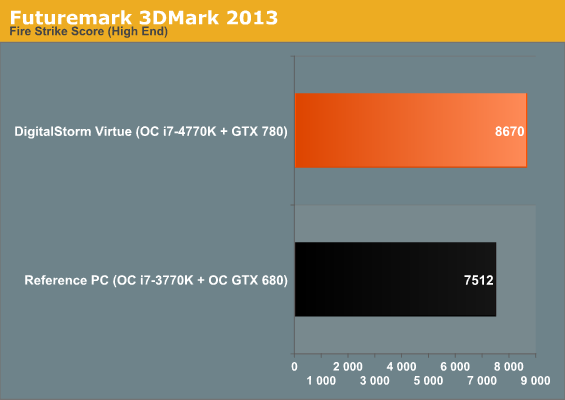
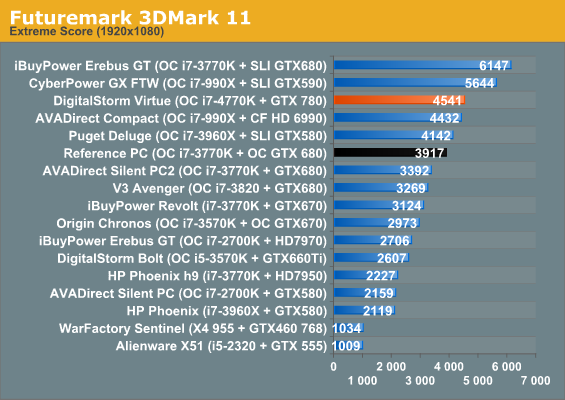
The 3DMarks pretty much tell the story. In both 3DMarks, a stock 780 is still ~15% faster than a heavily overclocked GTX 680.
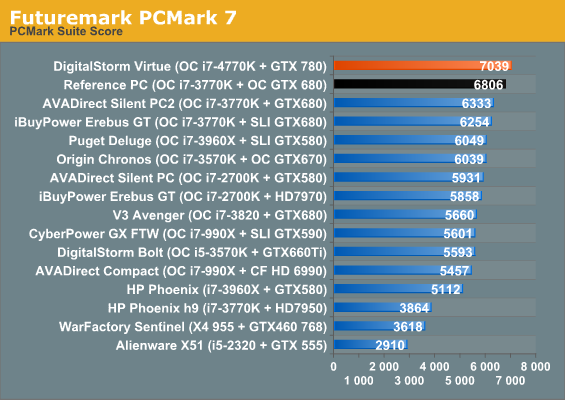
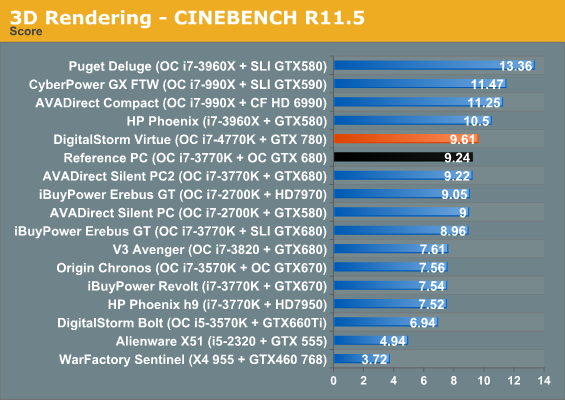
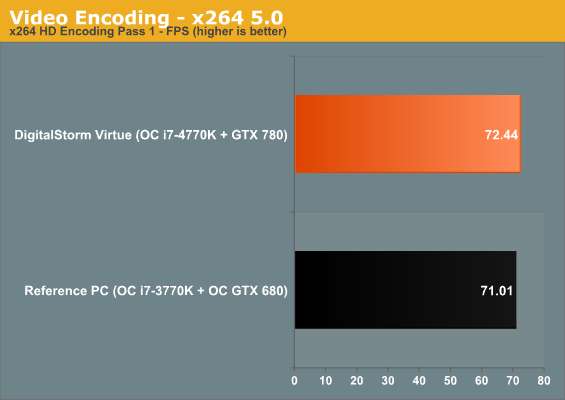
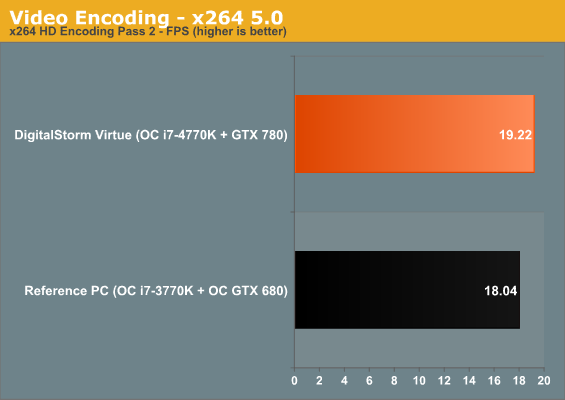
While PCMark7 tends to simply favor newer, faster SSDs, the difference between Haswell and Ivy gets a lot uglier when we isolate CPU performance. Consensus is that we've lost a bit of overclocking headroom with Haswell, making the comparison between a 4.6GHz Ivy and 4.4GHz Haswell a reasonably fair one. Cinebench is just 5% faster on Haswell, the first pass of the x264 benchmark is a dismal 2% faster on Haswell, and the second pass is at least a slightly healthier 7%.
Also note the improvement from Sandy to Ivy in Cinebench, though: our fastest Ivy is just 2% faster than our fastest Sandy. That Sandy was also running at 4.6GHz. Ivy at least brought a fat reduction in power consumption and TDP from Sandy despite the mediocre IPC improvement, but Haswell actually increased power consumption.
The math gets even uglier when we compare Sandy to Haswell. A 4.4GHz i7-4770K is only 6% faster than a 4.6GHz i7-2700K. That means that in two subsequent generations, the performance ceiling has barely moved. Anand is keen to point out that Intel's ability to eke out ~10% additional IPC on the same 22nm process node with a new architecture is impressive, and that may be true from a technical perspective, but Intel has offered enthusiasts virtually nothing new for two generations running. So whether or not the technical achievement is notable, end users are still left holding the bag. At this point, if you're hankering for more performance on the CPU, your best bet is actually to either go for an i7-3930K or wait for Ivy Bridge-E and hope Intel doesn't bone us with thermal paste instead of fluxless solder again. The only real selling point of Haswell, as far as I'm concerned, is access to the Z87 chipset.
Thankfully, while the jump in price from the NVIDIA GeForce GTX 680 to the GTX 780 isn't a particularly happy one, at least that dial moved pretty substantially. We tested every game at our Enthusiast settings (essentially maxed out and topping out at 4xMSAA), at 1920x1080 and then at 5760x1080.
|
GTX 680 1080p |
GTX 780 1080p |
% Perf. Increase |
GTX 680 Surround |
GTX 780 Surround |
% Perf. Increase |
|
| BioShock Infinite | 83.1 | 91.6 | 10.2% | 32.5 | 37.1 | 14.2% |
| Elder Scrolls V: Skyrim | 93.4 | 104.1 | 11.5% | 72.1 | 75.7 | 5% |
| GRID 2 | 87.3 | 109.2 | 25.1% | 39.4 | 49.2 | 24.9% |
| Metro: Last Light | 36.7 | 40.7 | 10.9% | 13.7 | 15.7 | 14.6% |
| Sleeping Dogs | 90 | 101.2 | 12.4% | |||
| StarCraft II: Heart of the Swarm | 73.5 | 86.2 | 17.3% | |||
| Tomb Raider | 64.3 | 72.5 | 12.8% | 31.8 | 36.5 | 14.8% |
So how do we interpret these results? First, excluding the outlying Skyrim surround results, even a diehard overclocked GTX 680 user can expect to net at least 10% more power from the GTX 780. Bumping up to 5760x1080 actually even lets the GTX 780 start to stretch its legs; while the 680 seems to be limited either by memory capacity or memory bandwidth, the 780's 384-bit memory bus and extra 1GB of GDDR5 do a solid job of picking up the slack.
Remember, too, that this is all before you overclock the 780. The consensus right now seems to be that the 780 has a very healthy amount of overclocking headroom, more than the 680 did, so if you're willing to sacrifice some power consumption and noise, you can theoretically push the 780 to Titan levels and even a bit beyond. At that point, it will pull away substantially from the 680 and by extension, the 770. I'm planning to do a custom liquid cooling review in the near future to get a grasp of just how far we can reasonably push a pair of GTX 780s, and given that I regularly see boost clocks of about 1GHz on them with just air cooling and no overclocking, I'm pretty optimistic.










70 Comments
View All Comments
wanderer000 - Sunday, June 23, 2013 - link
Anything and everything is a bit of a stretch there.p1esk - Sunday, June 23, 2013 - link
Well, let's just say I should have the widest possible range of components to choose from, that will fit into their design.Rick83 - Sunday, June 23, 2013 - link
The advantage is mostly in the hands-off warranty. As long as everything goes well, you're good building yourself, but I can imagine better ways to spend time and money, than to debug every component of my system, because I get odd bluescreens.p1esk - Sunday, June 23, 2013 - link
Did you even look at their warranty?Their default warranty covers defective components for 1 year, and if you want to extend it to 2 or 3 years, you pay $99 and $299 correspondingly. Pretty much every component you buy on Newegg has better warranty that this. So, basically, their warranty is a joke.
If you get an odd BSOD, you better know how to debug it (not rocket science, most issues relate to faulty RAM, which is easy to check), otherwise you will have to ship your system to them (and pay for shipping).
Honestly, I don't remember the last time I had problems with my builds, just buy quality components, read reviews, and chances of a problem will be tiny.
kuraegomon - Sunday, June 23, 2013 - link
The cost of paying a tech to build and burn-in the system, plus system warranty, isn't worth 10% over Newegg costs? Really? That's a very good margin from a customer point of view. If you don't like it, then don't pay it. By definition, if you're a confident enough builder and are willing to spare the time, you're not a target customer for boutique builders anyway.Note that I qualify on both fronts, so would never buy this system. However, I've also worked as a system builder and integrator, and from that viewpoint I think this system represents very good value.
p1esk - Sunday, June 23, 2013 - link
See my comment above about their warranty.Essentially, their value is assembly of components. For a technician who does it every day, it should not take more than 1 hour to assemble, overclock and test a system. That technician typically makes $15-25/hour.
So, again, what do they offer for the extra $200 they charge, which actually cost them $20?
JDG1980 - Sunday, June 23, 2013 - link
I think these kind of systems are aimed at gamers who aren't "enthusiasts" in the more general sense. Just because you like playing games on a PC doesn't mean you feel comfortable building a PC out of components, or even installing Windows from scratch. To you and I, those things are second nature, but most people can't do them.p1esk - Sunday, June 23, 2013 - link
Most gamers who are not "enthusiasts" will probably just go to Dell/HP website, or to their local BestBuy store, or ask their more knowledgeable friends for an advice on what to buy at Dell or BestBuy.When buying a new computer on their own, their choice will be primarily determined by brand awareness. DigitalStorm does not have any.
TheScottyB - Sunday, June 23, 2013 - link
DigitalStorm might not be as big as Dell or HP, but they've been doing well enough over the past 10 years to move into this facility four years ago: http://www.digitalstormonline.com/forums/facility-...They probably also have dedicated sales/accounts managers for maintaining a relationship with customers of their workstation products. This would let them avoid being dependent on the health of a single market.
And at a given price-point their machines have more value than a similarly-priced Dell or other global brand. They might not be the first brand in mind for a gamer, but any gamer who checks them out after seeing an article on a gaming news site will find a better machine for less. Whether or not they take the leap then depends on how much they trust the source. That's why sending machines to reviewers is so important to companies like DigitalStorm.
I don't work for a company exactly like DigitalStorm, but with regards to technician rates for custom builds or upgrades I get paid $15/hr but my employer charges either $60/hr or a flat fee based on the number and types of components. Whoever closed the sale also gets a small commission. From what I understand, a warranty extension for $99 is pretty typical of our competitors, but my employers charges more. However, we also offer warranty renewals if the customer allows us to perform a system checkup. There's a lot of overhead that eats into whatever the markup appears to be if you go strictly off the BOM.
Gigaplex - Monday, June 24, 2013 - link
1 hour is optimistic, running extended memtests and imaging the software etc takes time. A large OEM would run lots of these in parallel but boutiques don't get large volumes of orders so don't get those economies of scale.